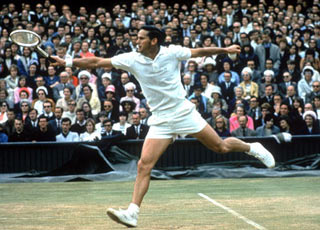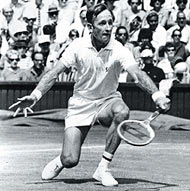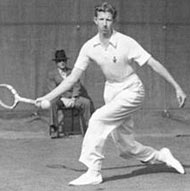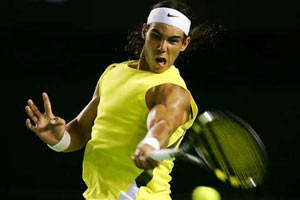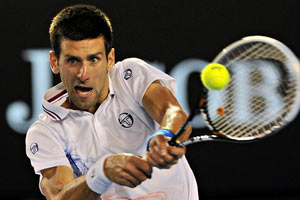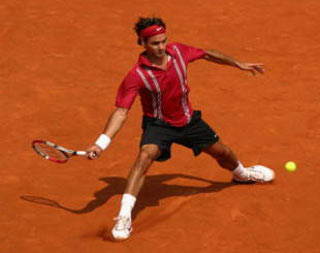|
TennisOne Lessons Playing for History in Paris Adam Gale It is something quite natural in the evolution of sports that, after a hundred years or so, an obsession with records should develop. Roy Emerson famously said that he wasn’t even aware he had the all-time lead in men’s singles majors until Pete Sampras came close to overtaking him in the late 90s, but you can bet Pete Sampras was all too aware of his own record as Roger Federer swept serenely towards it ten years later.
Of course, there are so many conceivable records, so many possible firsts, that something historic can be found in nearly every tournament, if only you look hard enough. At one event, you might witness the first time a Maltese player breaks into the world top 250; at another, the all-time record broken for most wins against left-handed Frenchmen. Clearly, not all records are that impressive or relevant, and not all tournaments are particularly historic. Every now and again, however, an event comes up which presents the possibility of ‘big’ history being made. This year’s French Open, which begins on Sunday, is one such event. What makes it so scintillating is that each of the three likely outcomes on the men’s side would mark a different and yet truly historic achievement. Rafael Nadal is, of course, the most likely victor. The Spaniard has been King of Clay since 2005, and for years now people have been calling him the greatest claycourter of all time. It is fairer to say he is in a group of two with Bjorn Borg, with whom he currently shares the record of six Roland Garros titles. I, for one, have always said he would need to surpass Borg at the French Open to be considered unequivocally the greatest clay court player in the history of the men’s game. Those who decide the odds for such things have Nadal as the favorite to do just that in just over two weeks’ time. It is hard to overstate how monumental this would be. To win any event that many times, let alone a major, let alone the French, generally considered to be the most physical and mental challenge in tennis, would be incredible. If anyone expects Nadal’s victory to be a coronation, however, or some formality, they need to think again. There are other contenders in the draw with history on their minds. Novak Djokovic, Nadal’s nemesis since the beginning of last year, comes into the tournament holding all three of the other majors. He is just the third man since Laver to have the chance to win all four in a row, alongside Sampras, Federer and Nadal.
Often, the ‘Grand Slam’ is regarded as the Holy Grail of tennis, on the one hand the highest prize possible in the sport, but on the other, a thing of legend, always elusive and out of reach. Only two men – Don Budge in 1938 and Rod Laver in 1962 and again in 1969 – have ever managed the feat since the French Championships joined the others in becoming international in the 1920s, and of these only Laver’s 1969 triumph was open to all comers, rather than suffering from the devaluing segregation of amateur and professional. If Djokovic could achieve the same on the swirling red dust of Paris, his place in the pantheon of tennis greats would be secured forever. Some would argue, I’m sure, that four in a row is not the same as a true, calendar Grand Slam. Indeed, it’s true that winning four in the same year looks neater in the history books, but, as I’m sure Serena Williams would be the first to argue, the difference is entirely superficial. The real achievement, surely, is holding all four of the biggest events in the sport, which involves taking them within a 52-week period. That we happen to have January 1st as the beginning of our ‘new year’ is arbitrary. If Djokovic were to claim the French, his Grand Slam might run from July 2011 to June 2012, but it would still be a Grand Slam, worthy of the same applause. The Serb will certainly fancy his chances. Unlike Federer, Djokovic believes he can hit Nadal off the court, even on clay. His seven consecutive victories in finals over the Spaniard over the last year or so seemed to have confirmed a decisive domination for the world number one over the man he had usurped. Last year, he became the first player since Nadal’s reign on the red stuff began in 2005 to notch up consecutive clay court victories over him. Ominously, incredibly, Djokovic’s triumphs over Nadal in Madrid and Rome in 2011 were even more emphatic than most of his hard court wins have been. Nadal never seemed that close to winning a set. Of course, Nadal stopped the run this year in Monte-Carlo and again in Rome. But how much of that was due to his own level and confidence returning, and how much was due to Djokovic’s flat performances? In the first match, Nadal achieved consistent depth on both his loopy, heavily-spun ground strokes, even in the face of strong aggressive play by the Serb. Time and again, this forced Djokovic back, allowing Nadal a relatively safe place to go in the rally. Crucially, Nadal was also confident in his aggressive play, lashing out with his vicious forehand time and again on short balls, inflicting damage particularly down the line and ‘out’ to the deuce court. His net approaches, when they came, were emphatic and his volleys and smashes strong. Alongside smart serving to the forehand side and very consistent returning, this all seemed to indicate that Nadal had at last found a way of neutralizing his devastating opponent, at least on the slow, slippery clay. It was difficult, however, to assess the efficacy of Nadal’s tactics, because Djokovic himself succumbed to a plague of unforced errors, handing Nadal an easy victory. The real test came in the rain-delayed Rome final, on the same court where Djokovic had inflicted his most psychologically damaging defeat on Nadal last year. Other than an uncharacteristic problem getting his first serve into play in the latter event, Nadal played about as well as he did in Monte-Carlo. Djokovic, however, was much stronger. Depth and loop did little to slow his cracking, on-the-rise ground strokes in Rome, despite the wet conditions. The tactics that had allowed the Serb to hit through the King of Clay in 2011 all also seemed to be functioning. Wide slice serves and angular, dipping topspin forehands to the deuce court opened up the ad side just as they did last year, creating the space for Djokovic’s immense forehands and backhands to make their impact felt. Aggressive, yet patient point construction allowed Djokovic to approach from strong positions to Nadal’s backhand, with similarly successful results.
Despite this, however, Djokovic did not win. In fact, he didn’t even take a set. The reason for this reversal of fortunes is quite simply that Djokovic played worse matches this year. His capabilities are the same, but last year he played immaculately in those two clay court finals, as in so many others. This year, he was shaky where he needed to be sublime, particularly in Monte-Carlo but also in Rome. There, at the business end of the first set, Djokovic ended up the wrong side of a bad call at 30-30 on Nadal’s serve, causing it to be replayed. Nine of the next 19 points ended with Djokovic unforced errors, gifting Nadal what was otherwise a close first set and handing him the crucial break in the second. Four unforced errors in his six subsequent break point chances arguably cost him his chance to get back in the match, which he ultimately lost on a double fault. Hardly the match play that won him the last three majors.
What Rome and Monte-Carlo prove is that Nadal is still going to be the man to beat on the clay of Paris, but that Djokovic still has the game to beat him. Whether he will be able to find that game if and when the time comes, especially with the added pressure of playing for the Grand Slam, remains to be seen. I certainly don’t expect Nadal to under-perform because he’s on the verge of seven French Open titles. Of course, a further clash of these two titans in Paris is not a foregone conclusion, apt though such an outcome would be. Aside from the many other dangerous players lurking in the draw, it would never be wise to forget Roger Federer. The Swiss has been playing sublimely in the last six months or so, after all and – who knows? – maybe he won’t have to play Nadal to win the thing. Not one to be outdone, Federer would himself also make history if he were to claim the title on June 10th. By doing so, he would become the first man since Laver to win each major at least twice, and would extend his extraordinary record slam haul to 17 and finals appearances tally to 24. Whoever wins this coveted title, whatever happens over the fortnight, it will be something remarkable. Great champions like Nadal, Djokovic, and Federer know this. They know that they are contending not just with each other but with history, not just for the glory of the title but for their place in the record books. Lesser mortals might fold under such the weight of such pressure, but not these. These are champions, and champions rise to the occasion. There may only be one winner at the end of this contest, but what a contest it will be.
Your comments are welcome. Let us know what you think about Adam Gale's article by emailing us here at TennisOne. |
